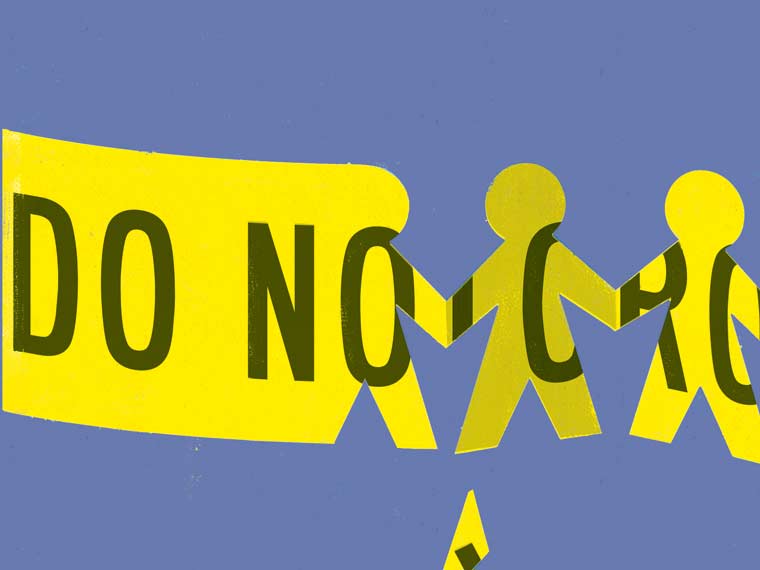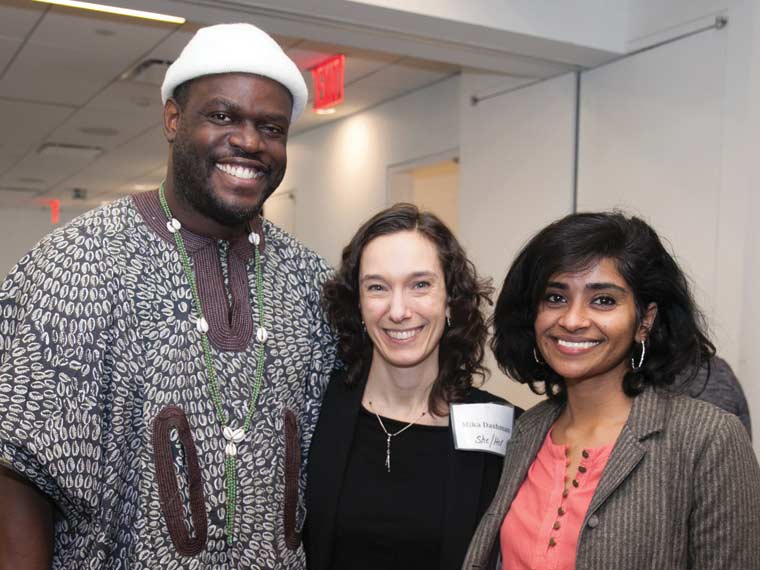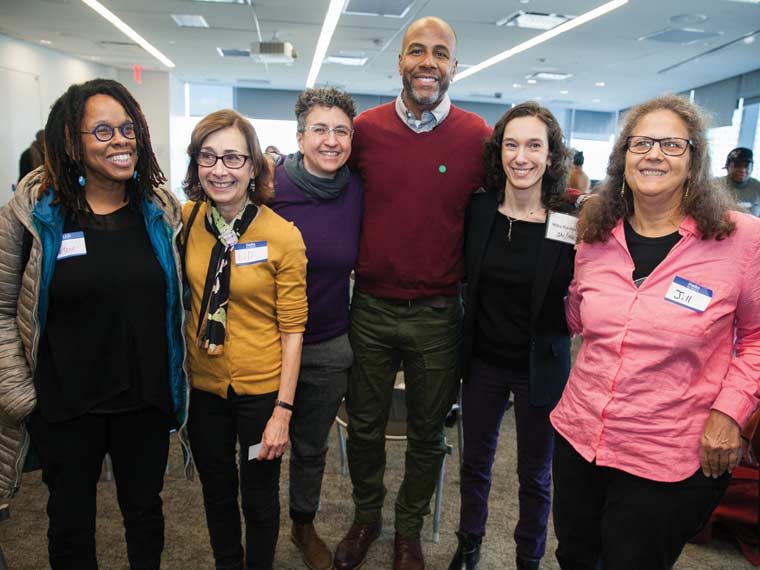Frustrated with the punitive nature of the criminal justice system, attorney Mika Dashman ’97 founded Restorative Justice Initiative to connect the efforts of practitioners and allies.

It was a time of pain and confusion for some 60 Brooklyn high school students: Their classmate had been shot in the head, and the teens descended on the hospital to offer support. But at the end of the day, says Jacquel Clemons, they were sent home “with nothing” other than their anguish.
As the chief operating officer at Kings Against Violence Initiative, a nonprofit that takes a public health approach to interrupting cycles of violence, Clemons knew the students’ despair could harden into cynicism or even retribution. She needed someone who could encourage the kids to share their suffering and vent their feelings, without judgment. So she reached out to Mika Dashman ’97, who runs another Brooklyn-based nonprofit, Restorative Justice Initiative. Typically, restorative justice involves having someone who was wronged—whether in a neighborhood spat or a violent crime—meet with the offender to talk about the harm done and how to make it right. More broadly, Clemons says, “It can be restorative for a community to just sit in a space and talk about what happened.”
Dashman called on her network of empathetic listeners, who met with the students the next day, hours after their classmate had died. Intervention was critical. “We know that unprocessed trauma lends itself to more trauma,” Clemons says. Restorative justice, Dashman explains, offers “a relational approach to justice that’s as much about proactive community-building as it is about responding to harm.”
When she established Restorative Justice Initiative in 2015, Dashman envisioned the organization providing connective tissue for communities throughout New York City that employ or might benefit from restorative justice, including in courthouses and schools. “Being a restorative justice facilitator is not about being the expert in the room,” she says. “It’s not about having the answers; it’s not about being in charge. It’s really just about holding space for people who are directly impacted, to ask, What do you need from each other?”
Dashman created the initiative after working seven years as an attorney helping low-income residents fight evictions from their homes and, before that, as a criminal defense investigator in the South Bronx. Both experiences convinced her that the law, as traditionally meted out, was failing communities, especially minority groups, because it hadn’t been set up to help them in the first place.
Although Dashman studied history and political science at Sarah Lawrence, her ultimate aim was to be on stage. When her first-year don suggested she focus more on the humanities, Dashman changed dons, then spent her junior year in London, studying drama. On the day she graduated, she moved to New York City and started auditioning. But after three years and few paid roles, Dashman began looking into a career that would be “more socially and politically engaged,” she says. Weighing the possibility of law school, she took a position in a public defender’s office in the South Bronx, where she went into the community to speak with witnesses and victims of crime.
“Being a restorative justice facilitator is not about being the expert in the room. It’s not about having the answers; it’s not about being in charge. It’s really just about holding space for people who are directly impacted, to ask, What do you need from each other?”
“I often got the other side of the story,” she says, from what defense attorneys were hearing from the accused. When the public defenders did their job well, they minimized the consequences for the defendant, which is important because the punitive system can cause further harm. But she found accountability to be in short supply, she says, because “sometimes our clients really hurt people,” and the hurt lived on in the community.
Meantime, all sorts of wrongdoing, including acting out in school, was being treated with “zero tolerance” policies that often put young people, most of them African American, into a school-to-prison pipeline. “Punitive responses really run counter to the goals of accountability, because they’re completely passive,” Dashman says. “But accountability is a really difficult, active process with multiple stages. You have to acknowledge that there was harm to begin with. You have to acknowledge your role in it. You have to acknowledge the impact, and you have to actually take proactive steps to ensure that it won’t happen again. People serve very long prison terms in this country and never have to do any of that.”
Ultimately, Dashman decided that criminal defense work wasn’t for her, though she still earned a law degree from the City University of New York School of Law. After passing the bar exam, she was hired by a nonprofit in Queens to help people living with HIV and AIDS retain housing and public benefits. She would often see the same clients coming back in need of assistance, repeatedly being mistreated by landlords. Dashman says she was “hungry” for an alternative to the conventional adversarial methods used in the law.
The only child of progressive parents, she’d been raised in the Hudson Valley by secular Jews and “adjacent to” Buddhism, which her mother teaches. She says she is attracted to the Jewish philosophy of tikkun olam, which is about repairing the world. “I don’t know why exactly,” she says, “but I have always felt a tremendous sense of responsibility for making the world right.”
Dashman’s life was changed in early 2013 by an article in The New York Times Magazine about a Florida couple who, after the murder of their daughter by her fiancé, almost immediately forgave her killer and asked the court system to take their forgiveness into account in his sentencing. What they sought was restorative justice, a concept still unfamiliar in a legal system built primarily around retribution.
Derived from First Nation tribes in North America, the Maori in New Zealand, and other indigenous cultures, restorative justice is founded on the understanding that a crime against one is a crime against all, and can often, though not always, be addressed by open, honest dialogue between those involved. “Victim-offender reconciliation practices” first began to be adopted in the mid-1970s among the large population of Mennonites in Ontario, and gained notice in America when Howard Zehr, a criminologist at Eastern Mennonite University in Virginia, wrote a book about the practices.
“It’s definitely her organization, but she carries it like it belongs to the people who are doing the work. There’s no ego in it whatsoever in the work she does. This is all heart.”
—Jacquel Clemons COO, Kings Against Violence Initiative
At the time, Dashman had never heard of restorative justice. But she says she instantly recognized its “larger social justice implications.” In fact, she “became obsessive about it,” she says, talking about it with everyone she knew and looking for examples of restorative justice being practiced in New York. She found some, but they were disconnected from one another and lacking a common sense of purpose. “I really thought there needed to be at least one person in New York City who had a sense of the big picture, who was looking at how all of the different things that were going on tied together, or could be tied together,” she says. But at that point no such person existed.
Though Dashman is a trained mediator in criminal cases, Restorative Justice Initiative does not conduct restorative justice dialogues. Rather, her job as the initiative’s sole staffer—she’s aided by about a half-dozen volunteers—is maintaining a clearinghouse and networking hub for more than 3,000 restorative justice practitioners and supporters in the city and beyond. “The secret sauce of my work is relationship-building,” she says. “I sometimes jest that I’m changing the world one coffee date at a time.”
Dashman traces a direct line from her work in restorative justice to her time at Sarah Lawrence. “The qualities that made me a successful Sarah Lawrence student are also the qualities that have made it possible for me to do this crazy thing that I’m doing,” she says, “which was to give up a perfectly well-paid professional career and start an organization from scratch based on this vision I had of something that didn’t exist.”
Jacquel Clemons says Dashman has been instrumental in providing community members with the restorative justice tools they need. “It’s definitely her organization, but she carries it like it belongs to the people who are doing the work,” says Clemons, who, with Dashman, is assembling a rapid response team to help address future crises. “There’s no ego in it whatsoever in the work she does. This is all heart.”
Dashman believes the potential of restorative justice in the area of education is even more vital than in the legal system, because if you want to change a culture, you start with the children. “In order for restorative justice to be implemented in different contexts with integrity, people really need to see it in a much more holistic way,” she says. “Because, ultimately, it is about relationships and community.”
To learn more about Restorative Justice Initiative, visit: restorativejustice.nyc
Written by John T. Ward
Photos by Maurice Pinzon
Illustrated by Chris Gash

Dashman (center) joins colleagues in January at the first Citywide Roundtable on Restorative Approaches organized by Restorative Justice Initiative and the Center for Creative Conflict Resolution. The event was hosted by the Office of Conflict Resolution at the NYC Department of Social Services.

Nearly 200 people supportive of restorative justice and restorative practices gathered for the inaugural event aimed at “fostering cooperation, connection, and community.” Participants represented a cross-section of New York City government agencies and nonprofit community-based organizations.